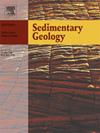Lithification of pelletal grains by microbially mediated organomineralization
IF 2.9
2区 地球科学
Q1 GEOLOGY
引用次数: 0
Abstract
Fecal pellets are key components of the biological carbon pump and a source of nutrients. When cohesively bound and cemented, they become the most abundant non-skeletal grains in shallow-water carbonates and an important nucleus for ooid formation. Herein, we describe the mineralization processes contributing to pellet cementation using scanning electron microscopy in conjunction with stable isotope and mineralogical analyses of the bulk sediments on Great Bahama Bank, known for its abundance of peloids and fecal pellets. Results show biogenic signatures consistent with the initial stages of organomineralization. These include, curved-tubular filaments and bacilli bacteria associated with extracellular polymeric substances (EPS); fibrils of EPS binding aragonite needles; and the coexistence of decayed EPS with amorphous calcium carbonate that once it develops, coalesces and crystalizes into aragonite. While δ13Cinorg do not show large variations, slightly higher values are observed in areas where pellets are indurated, likely attributed to photosynthetic activity on the pellets. The δ13Corg values tend to be more elevated in indurated pellets, suggesting that heterotrophs are preferentially using enriched carbon sources. In contrast, friable pellets from nearshore areas show more negative δ13Corg values, suggesting microbial exposure to depleted C3 and CAM plant sources. Fingerprints of nitrogen fixation and denitrification are also documented and supported by δ15Norg values. Altogether, these findings suggest that EPS and a microbial consortium, including gut-microbial flora and free-living surface colonizers, are responsible for inducing early cements, which are later complemented by secondary cements. Microorganisms involved in pellet lithification may subsequently also aid in ooid cortex development.
微生物介导的有机矿化作用下颗粒颗粒的岩化作用
粪便颗粒是生物碳泵的关键组成部分,也是营养物质的来源。当黏结胶结时,它们成为浅水碳酸盐中最丰富的非骨架颗粒,是形成流体的重要核心。在此,我们使用扫描电子显微镜结合稳定同位素和矿物学分析描述了有助于颗粒胶结的矿化过程,并对大巴哈马滩的大块沉积物进行了分析,该滩以其丰富的球状体和粪便颗粒而闻名。结果显示生物成因特征与有机矿化的初始阶段一致。这些包括弯曲管状细丝和与细胞外聚合物质(EPS)相关的杆菌细菌;EPS结合文石针的原纤维;腐烂的EPS与无定形碳酸钙共存,一旦形成,就会凝聚并结晶成文石。虽然δ13Cinorg没有显示出大的变化,但在球团硬化的地区观察到略高的值,可能归因于球团的光合作用。在硬化颗粒中δ13Corg值趋于升高,表明异养生物优先利用富集的碳源。相比之下,来自近岸地区的易碎颗粒显示出更多的负δ13Corg值,表明微生物暴露于耗尽的C3和CAM植物源。固氮和反硝化的指纹图谱也被记录下来,并得到δ15Norg值的支持。总之,这些发现表明,EPS和一个微生物联合体,包括肠道微生物菌群和自由生活的表面定植菌,负责诱导早期水泥,随后由二次水泥补充。参与颗粒石化的微生物可能随后也有助于卵皮质的发育。
本文章由计算机程序翻译,如有差异,请以英文原文为准。
求助全文
约1分钟内获得全文
求助全文
来源期刊

Sedimentary Geology
地学-地质学
CiteScore
5.10
自引率
7.10%
发文量
133
审稿时长
32 days
期刊介绍:
Sedimentary Geology is a journal that rapidly publishes high quality, original research and review papers that cover all aspects of sediments and sedimentary rocks at all spatial and temporal scales. Submitted papers must make a significant contribution to the field of study and must place the research in a broad context, so that it is of interest to the diverse, international readership of the journal. Papers that are largely descriptive in nature, of limited scope or local geographical significance, or based on limited data will not be considered for publication.
 求助内容:
求助内容: 应助结果提醒方式:
应助结果提醒方式:


